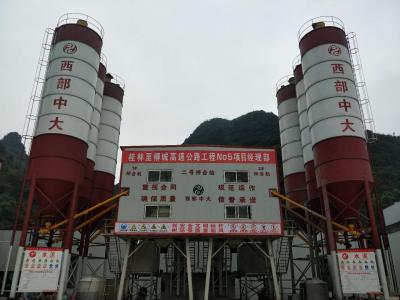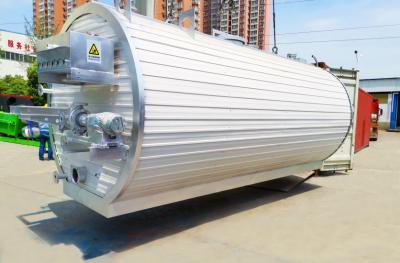Commercial concrete mixing plant mixing time requirements
Commercial concrete mixing plant mixing time requirements
I. Risks of sending stones to the mixing plant
The risks are divided into three major aspects: production safety hazards, transport safety hazards and quality safety hazards. Production safety hazards: mainly based on ensuring personnel safety, equipment maintenance and normal production. Transport safety hazards: The emphasis is on the avoidance of social vehicles during the transport of concrete tankers, the safety of driving in the construction site, etc. Quality safety hazards: incoming inspection of raw materials, controlled management of incoming materials, measures to deal with unqualified materials, etc. In a word: safety first, quality first, guaranteeing production, which is one of the rules of survival of the mixing plant. The concrete mixing plant is mainly composed of 5 major systems such as mixing host, material weighing system, material conveying system, material storage system and control system and other ancillary facilities.
Second, the quality of masonry structure works in line with the acceptance specifications are
(A) material requirements
1. The brick species, specifications, strength level must meet the design requirements, and should have product certification and performance test reports, after the field should be sampled for re-inspection, after passing before being allowed to use
2. Masonry mortar should be applied in accordance with the design requirements before the masonry ratio, construction should be strictly in accordance with the mortar ratio notice sheet for material measurement, and fully mixed.
3. Construction site masonry blocks should be stacked neatly, stacking height should not exceed 2m, there are rain requirements to prevent rain and good drainage, block to keep clean.
(II) Quality control of construction works
1. The consistency of masonry mortar after mixing should be 60 to 80mm.
2. Masonry mortar should be randomly sampled as required and test blocks set aside to be sent to the laboratory for compressive strength testing. On-site masonry mortar should be used as it is mixed, cement mortar and cement mix mortar must be used within 2h and 3h after mixing respectively.
3. Masonry brick masonry, brick should be watered 1 ~ 2d in advance wet. Ordinary brick, porous brick moisture content should be 10% ~ 15%; gray sand brick, fly ash brick moisture content should be 8% ~ 12%. Construction site sampling brick moisture content of the simplified method can be used on-site broken brick, brick cross-section around the depth of melt water for 15 ~ 20mm is considered to meet the requirements.
(1) with light aggregate concrete small hollow block or autoclaved aerated concrete block masonry filling wall, the bottom of the wall should be sintered ordinary brick or porous brick or concrete small hollow block, or on-site pouring concrete Kantai, etc., its height should not be less than 200mm. toilet and bath room and waterproof requirements of the room, the bottom of all walls within 200mm height should be poured concrete Kantai.
(2) Before the masonry of the wall should be carried out in the field for a test row of blocks, the principle of row of blocks is the upper and lower staggered, block lap length should not be less than 1/3 of the block length. if the block length is less than or equal to 300mm, its lap length is not less than 1/2 of the block length. when the lap length is not enough, should be placed in the grey joints of the tie reinforcement.
(3) masonry before the establishment of the skin number of poles, skin number of poles should be set up in the corners of the house and the intersection of internal and external walls, spacing to 10 ~ 15mm appropriate, masonry blocks should be pulled by the skin number of poles masonry.
(4) The grey joints of brick masonry should be horizontal and vertical, evenly thick and thin. The thickness of the horizontal grey joints and the width of the vertical grey joints should be 10mm, but should not be less than 8mm, and should not be greater than 12mm. masonry method should adopt the "three one" bricklaying method, that is, "a shovel of ash, a brick, a kneading squeeze" method of operation. The vertical grey joints should be used to squeeze the slurry method or add slurry method, so that its mortar full, strictly forbidden to use water to wash slurry filling joints. If the masonry method is used, the length of paving shall not exceed 750mm, and when the construction temperature exceeds 300C, the length of paving shall not exceed 500mm.
(5) block arrangement should be as far as possible using the main specifications, in addition to the necessary parts, as little as possible inlaid hollow brick masonry, local need to set the location of the brick easy to disperse, symmetrical, in order to make the masonry force uniform. When masonry external walls, shall not leave footing eyes, can be used in the footing or double row footing. Design of holes, grooves, pipes and pre-buried parts should be left with the masonry and pre-buried, not later chiselled.
(6) vertical and horizontal walls as a whole bite hew masonry, temporary interruptions can be towed oblique hew, oblique hew horizontal projection length should not be less than 2/3 of the height. hew, should first clean up the base, water wet, and then paving slurry joint masonry, and do full of gray joints. The tie bars on the structural column of the frame should be placed accurately and firmly, and their exposed parts should not be bent arbitrarily during construction. The wall buried electric pipe, can only be buried vertically, shall not be horizontal groove, open vertical joints shall not hammer axe chisel, electric pipe diameter should not be greater than 25mm. fixed according to the provisions of the pipe valve, water to wash away the powder in the mortar filled with a number of times, the pipe valve buried should be completed before plastering.
III. Gypsum thin plastering mortar standards
Gypsum mortar mixing, using hand-held electric mixer mixing, continuous mixer mixing, mixing time of not less than 2min the mixing with the use, mixing should be completed within 45min after the use of stop manual mixing gypsum mortar. When mixing at high temperature, it is necessary to prevent high wind from causing rapid water loss on the surface of gypsum mortar caused by cracking, and prevent high temperature from causing short drying time.



